| Kyoto Cooking Circle monthly recipe |
|||
| Simmered Kiriboshi-daikon (KCC- style) | |||
| We introduce ‘Kiriboshi-daikon (Dried strips of radish)’ as the most common dried food in Japanese home-style cooking. Kiriboshi-daikon is the dried and shredded fresh daikon, and it is produced during the cold winter by drying outdoors. Traditionally, its production started in the Edo-era, and it still has made by a traditional process. Nowadays, about 90% of Kiriboshi-daikon, it is produced in Miyazaki-prefecture, Kyushu-direct. It provides a good supplement from a nutritional point of view, for example: 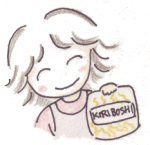 1. It is rich of fiber, 1. It is rich of fiber, 2. Its amount of calcium is 4 times more than milk (perfect for the bone formation), 3. Its amount of iron is the same as liver (good for avoid anemia). Also it is very useful and convenient ingredient to cook easily (already shredded), and it is possible conserve it for long time. 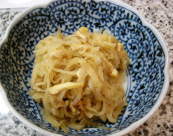 ←※"Simmered Kiriboshi-daikon" is one of very traditional Japanese Mom's taste. Additionally three arranged recipe (Pasta, Salad and Soup) using Kiriboshi-daikon are shared and we hope you enjoy them, too. |
|||
| Ingredients (4 servings): |
|||
 30g Kiriboshi-daikon and 400cc water, 30g Kiriboshi-daikon and 400cc water, 1/2 piece of abura-age (deep fried been curd), Sauce: 1 tbsp light soy sauce, less than1 tbsp sugar, 1 tbsp sake, 2g dried bonito flakes |
|||
| Directions: | |||
1.Soak Kiriboshi-daikon in water about 5 minutes. Squeeze out the water.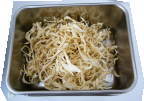 → → 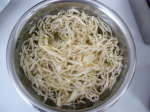 2.Cut in pieces long about 4cm. Save 200cc of reserved water for later use. 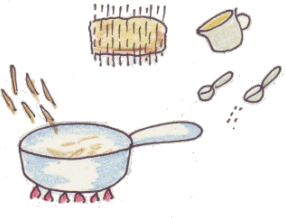 3.Cut abura-age in pieces width about 1cm. Add all sauce ingredients, and cook it, mixing on a medium heat until the sauce is ready. |
|||
*Notes *
|
|||
ページトップへ戻る レシピページへ戻る Back to the top of this page Back to the RECIPE page |
|||
| Copyright(C) 2004, Kyoto Cooking Circle. All Rights Reserved : kyotocookingcircle@yahoo.co.jp |
|||
